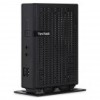ViewSonic SC-T45 SC-T35 / SC-T45 ViewSonic Device Management (English) - Page 106
Desktop Virtualization and Client Configuration, Client Settings at a Glance
 |
View all ViewSonic SC-T45 manuals
Add to My Manuals
Save this manual to your list of manuals |
Page 106 highlights
Configuring Client Settings Desktop Virtualization and Client Configuration 4.1 Desktop Virtualization and Client Configuration The desktop virtualization is available in various forms: user state virtualization, application virtualization, session based virtualization, virtual machine based virtualization, or even a hybrid approach. ViewSonic clients can meet a wide range of desktop virtualization forms and needs. To get your client ready for use, you might need to configure client settings to meet the specific needs in your desktop virtualization plan. 4.2 Client Settings at a Glance The following table provides brief descriptions of client setting items. NOTE • The available tabs and setting items may vary, depending on the client model and the used operating system. • Some setting items are only available locally on clients. You can adjust those settings through ViewSonic Client Setup. In the table below, all settings that are only available locally on clients are marked with an asterisk (*). Tab Setting Remote Desktop Citrix ICA Citrix XenApp VMware View Applications GO-Global Web Browser Icon Description Click to configure RDP (Remote Desktop Protocol) connection settings and create shortcuts on the local desktop and START menu for Remote Desktop sessions. Click to configure Citrix ICA (Independent Computing Architecture) connection settings and create shortcuts on the local desktop and START menu for ICA sessions. Click to configure Citrix XenApp connection settings and create a Start menu folder and/or desktop folder for accessing application delivery services. Click to configure VMware View connection settings and create shortcuts on the local desktop and START menu for View sessions. Click to configure GO-Global Client connection settings and create shortcuts on the local desktop and START menu for accessing application delivery services. Click to configure general (for WES-based clients only) or specific browser session settings. A desktop shortcut is created for specific browser sessions launched with the desired initial web page. The used Web browser may vary, depending on the operating system of your client model. SSH XDMCP Click to configure SSH (Secure Shell) session settings and create shortcuts on the local desktop and START menu for SSH sessions. Click to configure XDMCP (X Display Manager Control Protocol) connection settings and create shortcuts on the local desktop and START menu for accessing desktop delivery services. Acrobat Reader Click to enable/disable Acrobat Reader on your client. 101















